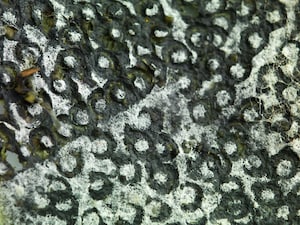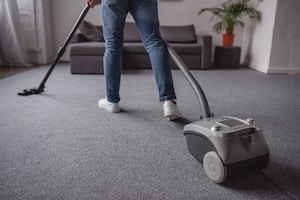Humidity, spills, wet and dirty shoes–all of this moisture gets trapped in your carpeting and turns your carpet into a breeding ground for mold spores.
Can carpet get mold? Carpeting is one of the highest risk areas of your home for mold growth. For mold to grow, it needs a food source, oxygen, moisture, and a surface to grow on. If mold spores happen to land on a damp or wet area of your carpet that contains dust, the spores will feed on the dust and you’ll soon have mold growth.
How to Get Mold Out of Carpet
 Can you get mold out of carpet? Yes, you can get mold out of carpet. There are several ways to remove it including baking soda and vinegar, water and dishwashing detergent, and bleach and water. It’s very important to remember that mold is highly toxic and you’ll need to protect yourself with eye protection, a mask, and gloves before you start to work on the affected area. In cases where the carpet mold is covering a large area, it may be worthwhile to hire a residental cleaning company.
Can you get mold out of carpet? Yes, you can get mold out of carpet. There are several ways to remove it including baking soda and vinegar, water and dishwashing detergent, and bleach and water. It’s very important to remember that mold is highly toxic and you’ll need to protect yourself with eye protection, a mask, and gloves before you start to work on the affected area. In cases where the carpet mold is covering a large area, it may be worthwhile to hire a residental cleaning company.
1. Baking soda and vinegar
The combination of baking soda and vinegar can help eliminate odors resulting from mold. If you have a light mold problem, baking soda and vinegar are two common pantry items that will do the trick. Sprinkle a generous amount of baking soda onto the carpet, then pour white vinegar into a spray bottle and generously spray the affected area overtop the baking soda.
2. Water and Dishwashing Detergent
You can also use a mixture of water and dishwashing detergent to clean your carpet. Use a sponge to thoroughly scrub the area.
3. Water and Bleach
If you have a severe mold issue, use bleach and water to clean the carpet. Pour one cup of bleach into a gallon of water and spray the solution on the carpet. After letting it sit for 15 to 20 minutes, use a wet dry vac to remove all excess solution from the carpet. This will prevent the mold from regrowing. It’s a good idea to open windows and run a dehumidifier to remove excess moisture and bleach odors in the carpet. NOTE: Bleach may discolor your carpet.

What is Mold
Mold is a fungus consisting of small organisms that are found almost everywhere, including the air. Molds can be white, black, purple, green, or orange. In the outdoor world, they play an important role in nature by breaking down dead plants, trees, and leaves.
Molds need moisture and reproduce by tiny, lightweight spores that travel through the air. These spores are usually harmless, but when they land on a damp area in your home, they can start to breed. When mold grows on a surface, its spores are released into the air where they can be easily inhaled and if you or a family member have a sensitivity to mold, you could experience health problems.
Signs That Your Carpet Has Mold
One of the tops signs of mold growth is a musty odor. Old carpeting that is well past its life span is more likely to grow mold spores. Carpet that has been exposed to water for a day or longer or is in a continually humid environment will be susceptible to mold. In some cases, mold will stain your carpet and you may be able to see black or green spots growing, but mold grows deep within the carpet fibers and even the backing, so you may not even know it’s there. The area underneath your carpet may develop discoloration before the carpet does, so you’ll want to look underneath the carpet if you are suspicious of mold.

Is Mold Harmful?
Yes, people may be more sensitive to mold spores than others and may cause sickness, especially those with asthma or allergies. Exposure to mold can irritate your eyes, throat, skin, lungs, and nose, whether or not you’re allergic to it. The allergens that are produced by mold in some cases can potentially be toxic. These are know as mycotoxins.
If you or someone in your family have a sensitivity to mold, touching or inhaling mold spores may cause an allergic reaction including sneezing, runny nose, skin rash, and red eyes. If you or a family member have a serious allergy to mold, then reactions can be more severe and include shortness of breath and asthma attacks.
In addition to people with asthma and allergies being sensitive to issues related to mold in your home, others who may be more sensitive include:
- People with chronic lung disease
- People with compromised immune systems due to HIV, cancer, liver disease, chemotherapy
- The elderly
- Infants and children
Symptoms of Mold Exposure
If you or a family member come into contact with mold, you could experience symptoms such as:
- Wheezing
- Skin rash
- Dry cough
- Red, watery eyes
- Sinusitis
- Sore throat
- Runny or blocked nose
How do you test carpet for mold growth?
Even though it’s recommended that any mold growth in your home be removed, it’s always a good idea to have it tested. If you’re suspicious that your carpet has mold growth, a very simple way to detect whether you have mold or not is to purchase a mold test kit and collect samples in strategic locations. A mold testing kit tests the airflow on your carpet. If there are mold spores in the carpet, they will land on the kit and from there you can begin the process of removing them.
Mold test kits are available at home improvement stores and from online retailers. Not all test kits are the same. Some are designed to determine whether the mold is present on a surface and others detect spores in the air you breathe. Make sure you purchase the correct type of test kit.
PRO TIP: The Environmental Protection Agency (EPA) recommends that homeowners have their homes professionally tested if they’re concerned about the presence of mold.
Why Does Carpet Grow Mold
If a carpet is clean enough it is highly resistant to mold growth, even if among conditions of high humidity. A study by the Carpet and Rug Institute (CRI) provides insight as to how mold grows in carpeting and the best way to avoid it. The study was conducted to determine whether humidity levels affected the growth of mold on carpeting.
The carpeting in various conditions–clean, dirty, old, new–was subjected to various levels of humidity. The finding they uncovered during the study was that dirt, more than humidity, was the highest contributor to mold growth. Carpets that were even lightly soiled bred more mold than clean carpets when subjected to the same levels of moisture.
PRO TIP: High humidity coupled with dirt equals mold.
Four Ways to Prevent Carpet Mold
If you have carpet in an area of your home with potentially high humidity, there are measures you can take to prevent mold growth.
- Keep your carpet clean. To prevent mold growth, vacuum your carpet weekly to keep it clean and free of dirt.
- Keep humidity low. To keep humidity low in a contained area, run a portable dehumidifier or provide airflow to the area by opening windows and doors (don’t open windows and doors if the humidity outside is high). You can also circulate air throughout your house with fans. Maintaining humidity of 65 percent or lower is the optimal level for maintaining a mold-free carpet.
- Keep temperatures low. Temperatures above 80 degrees can contribute to mold growth in the carpet. Installing central or portable air conditioning will help with both temperature and moisture because as the air cools, it lowers the humidity.
- Use synthetic carpet materials. Synthetic fibers are a good choice because they release moisture and avoid mold and mildew build-up. Organic carpet material such as wool is more susceptible to mold growth than synthetic, non-organic material such as nylon or olefin.
Can You Control Mold?
Although molds are part of the natural environment and are found everywhere, indoors and outdoors, it’s not a problem until it begins to grow indoors. There is no practical way to eliminate all mold and mold spores in your indoor environment–the best way to control mold growth is to control moisture. In areas where moisture is a perpetual problem, it’s recommended not to install carpeting.
Mold vs. Mildew
Mold and mildew have similar characteristics and thrive in warm, moist areas. They can each grow on a variety of surfaces, from food to your shower to a sheet of paper. But they are different in terms of size, color, and texture.
- Mildew refers to a certain type of mold or fungus and is generally used to refer to mold growth. It’s a surface fungus that can be identified as a patch of gray or white fungus on the surface of a moist area and can be easily treated with a store-bought cleaner and scrub brush. Mildew grows in a flat pattern and appears powdery or fluffy.
- Mold can be black or green and usually appears fuzzy or slimy. It’s typically the result of a much larger infestation. Molds include all species of microscopic fungi that grow in the form of multicellular filaments and they can thrive on any organic matter such as clothing, leather, paper, carpeting, ceilings, walls, floors, and places where moisture levels are high.
Black Mold
The sinister-sounding black mold sounds so for a reason–it is an infestation that appears in parts of your home that are especially damp, humid, and warm. These types of mold spores love growing on insulation, wet paper, drywall, and wood. According to the Centers for Disease Control (CDC), black mold can cause wheezing and coughing in healthy people. For those with weakened immune systems, the health risk can be higher and include symptoms like breathing problems, memory loss, headaches, flu-like symptoms, and coughing blood.
The good news is that this type of mold is not found as commonly as other indoor molds because it requires far more moisture than most. By controlling the moisture in your home, you likely won’t have to deal with black mold anytime soon.
